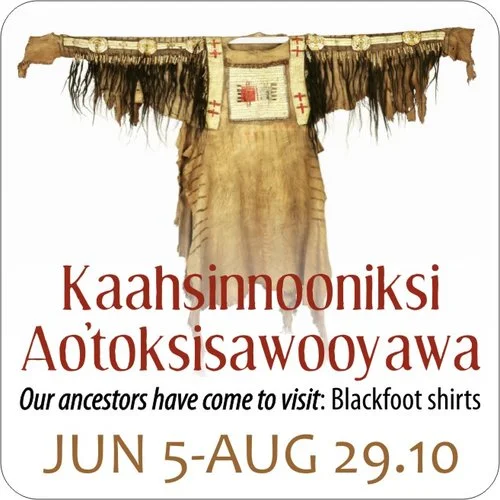Miksiksipoksapowowa (Revenge Walker) was the half-sister of Mékaisto (Red Crow). She was politically and socially engaged in her community and her tribe.
Read MoreA diplomat and mother, Natawista played a key role in helping establish treaties and navigate negotiations between American and British traders with Blackfoot tribes.
Read MoreIn 2010, the Galt Museum & Archives hosted an exhibit called Kaahsinnooniksi Ao’toksisawooyawa Our ancestors have come to visit: Blackfoot Shirts.
Read MoreMaking needle books was a trend that began in the 1800s and grew in popularity until around the 1950s. These needle books were designed to hold the different needles a person would need for different fabrics and projects. Usually the needle book was made out of scrap fabric or a fun creative fabric. They were used to organize and secure needles.
Read MoreThe very first school built in Lethbridge was the Lethbridge Public School Building and it had some features that are not at all familiar to schools in Lethbridge today. Constructed in 1888, it included a large fence to keep cattle out of the school yard.
Read MoreThe Plat of Zion used to establish the layout of Mormon colonies in the United States, Mexico and Canada was intended for exactly such mixed usage in the hopes of promoting self-sufficiency and even eliminating crime.
Read MoreHave you ever wondered why the streets in towns like Raymond, Magrath, Stirling and Cardston are so wide? It all has to do with a utopian city planning tool designed by founder of the Mormon Church, Joseph Smith, in June 1833 called the Plat of Zion.
Read MoreIn July 2019, the Galt's Archives received an inquiry about the history of Holiday Trailers Ltd. by an individual who found one of their trailers in a field in British Columbia. They were looking for information on the company to help their efforts to restore this vintage trailer to operation.
Read MoreWilliam Hasulak documented the City of Lethbridge from 1950 to 1990. Hasulak's photographs showcase what our city has to offer. Over the course of 40 years, he captured the changes that Lethbridge experienced. From the Centennial celebration in Brewery Gardens to the first snowfall at Henderson Lake, Hasulak’s photographs mapped out the city’s history.
Read MoreWest Lethbridge was considered a “planners’ dream”—a chance to experiment with contoured streets and a new “neighbourhood village” concept incorporating residential, retail and recreational services.
Read MoreIn the 1880s, Lethbridge went from coal mining camp to boomtown. The population shifted in 1885 from the river valley into a newly surveyed townsite on the prairies. The Southside boomed.
Read MoreBy the early 1980s, 50 of the 100 doctors on staff at St. Michael’s were involved in obstetrics in some way.
Read MoreTo meet the growing demand for nurses, the Sisters of St. Martha applied to the University of Alberta to open a new school of nursing, which was approved in November 1950.
Read MoreAs the population of Lethbridge expanded, “St. Mike’s” evolved to meet the needs of the community. An east wing was added in 1951, providing 83 more beds to the facility; this brought the total to 181 beds and 18 bassinets.
Read MoreFor the next ninety years, the Sisters were involved in all aspects of nursing at St. Michael’s from teaching to administration to patient care. They were respected for their discipline and compassion.
Read MoreThe Greetergrammers performed for any special occasion that a client would request. They performed for birthdays, proposals and going away parties.
Read MoreBy 1945, the streetcar system had reached a critical moment. The remaining carriages were falling apart and parts to repair them were scarce, especially during wartime.
Read MoreLethbridge city council invested more than half a million dollars in the new streetcar system. Mayor George Hatch opened the first 17 km of tracks on August 17, 1912.
Read MoreFor 35 years, the sound of the streetcar’s bell was both a familiar and important sound in Lethbridge, for it signified the streetcar.
Read MoreWorking with parking meters was a difficult job in the summer and the old equipment became progressively more in need of replacement over time.
Read More



















